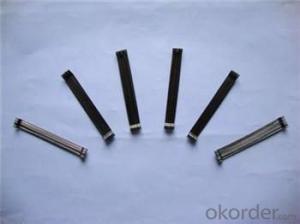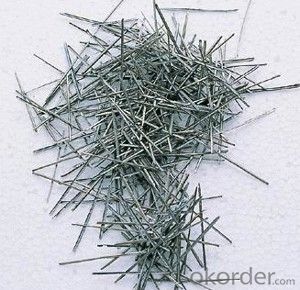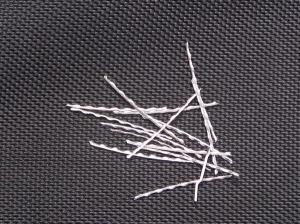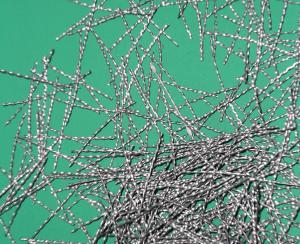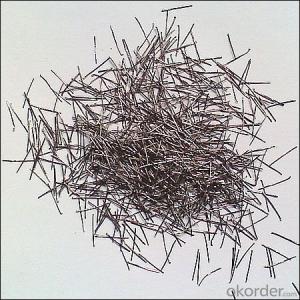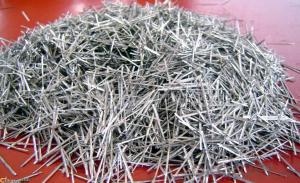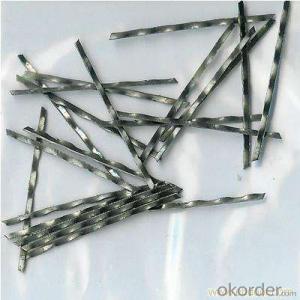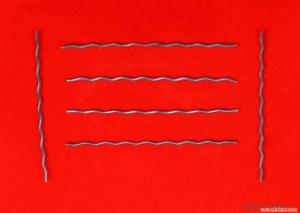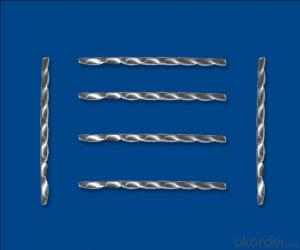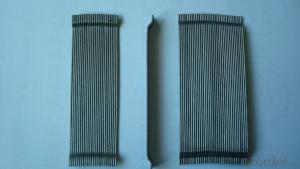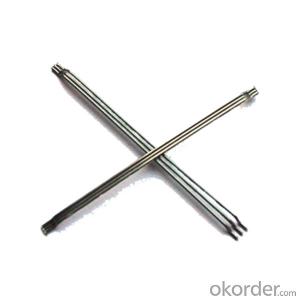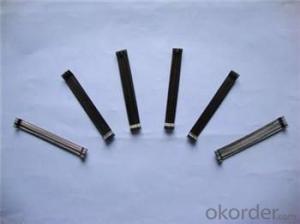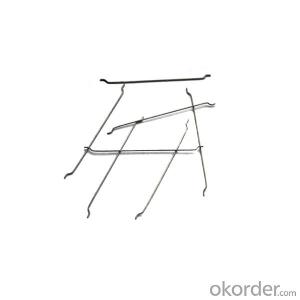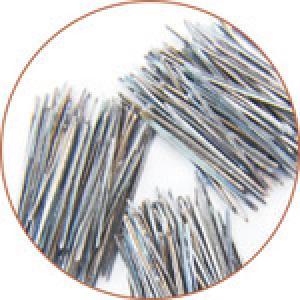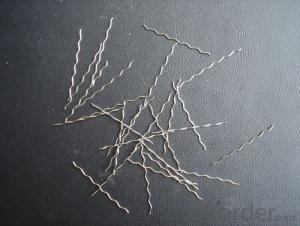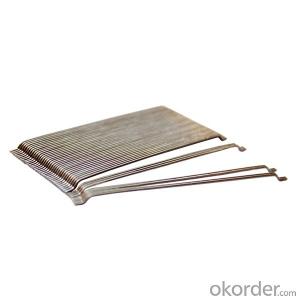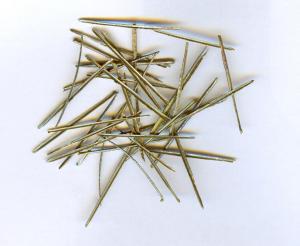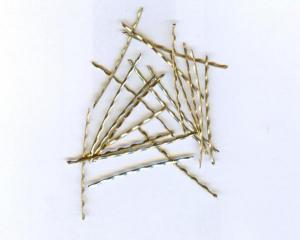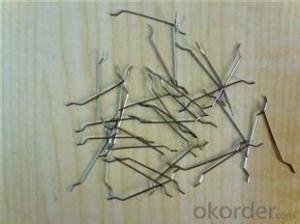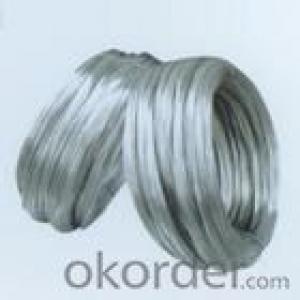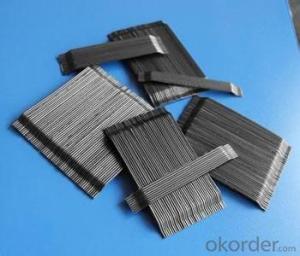Melt Extract Stainless Steel Fiber for Construction Companies UAE High Quality
- Loading Port:
- Tianjin
- Payment Terms:
- TT OR LC
- Min Order Qty:
- 1 m.t.
- Supply Capability:
- 600 m.t./month
OKorder Service Pledge
Quality Product, Order Online Tracking, Timely Delivery
OKorder Financial Service
Credit Rating, Credit Services, Credit Purchasing
You Might Also Like
Quick Details
Place of Origin: Tianjin, China (Mainland)
Model Number: 0.55
Material: Steel
Production Process: Cold drawn
Fiber Lengh: 35
Type: 1
Compressive Strength: >1200MPa
Aspect ratio: 63
Standard: ASTM A820M-11
Section Shape: Circular
Application: Concrete Reinforcement
Product Application: Industrial Floor
Packaging & Delivery
| Packaging Details: | 20 kg/Bag,50 bags/Pallet or 1,000kg/ Bulk Bag |
|---|---|
| Delivery Detail: | 1 Month |
Product Description
| Diameter | 0.55 mm (0.217 in) | ||
| Length | 35 mm (13.780 in) | ||
| Aspect Ratio | 63 | ||
| Tensile strength | 1200 MPa | ||
| Type | Cold drawn Steel Fiber | ||
| End | Hooked-end Steel Fiber | ||
| Glued/Loose | Glued Steel Fiber | ||
| Bending Angle | 45°(min.30°) | ||
| Usage & Performance | Floor:Trafficked areas and Industrial floors | ||
| Shotcrete :Slope stabilization and Final lining | |||
| Precast concrete:Pipe and Railway sleepers | |||
| Packing | Standard Export Pallet Packing | Bag Packing | 20 kg/Bag,50 bags/Pallet |
| Bulk Packing | 1,000kg/ Bulk Bag | ||
| Loading Quantity | 20’GP | 20-25 Tonne/Tonnes | |
| 40’GP | 25-27 Tonne/Tonnes | ||
| 40’HQ | 25-27 Tonne/Tonnes | ||
| MOQ | 1 kg for trial order | ||
| Supply Ability | 10,000 Tonne/Tonnes per Year | ||
| Payment Terms | T/T or L/C at sight | ||
| Delivery Time | Within 15 days after receiving deposit or original L/C at sight | ||
| Certification | ISO9001:2000, CE, | ||
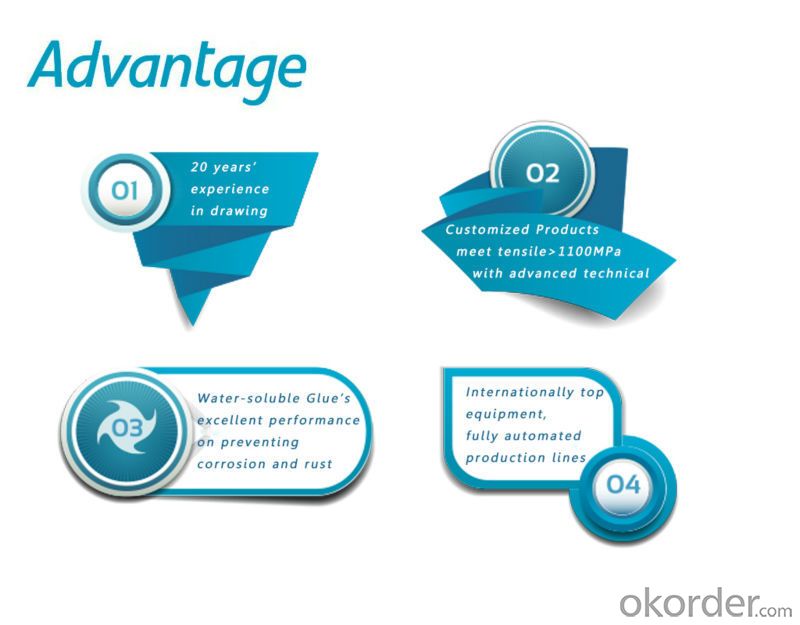
| Product | Diameter | Length mm/in | Aspect Ratio | Type | Packing |
| G-6030 | 0.5 mm (0.197 in) | 30 mm (11.811 in) | 60 | Glued | 20 kg/Bag, or 1,000kg/ Bulk Bag |
| G-6535 | 0.55 mm (0.217 in) | 35 mm (13.780 in) | 65 | Glued | 20 kg/Bag, or 1,000kg/ Bulk Bag |
| G-6035 | 0.6 mm (0.236 in) | 35 mm (13.780 in) | 60 | Glued | 20 kg/Bag, or 1,000kg/ Bulk Bag |
| G-8060 | 0.75 mm (0.295 in) | 60 mm (23.622 in) | 80 | Glued | 20 kg/Bag, 50 bags/Pallet |
| G-6060 | 0.9 mm (0.354 in) | 60 mm (23.622 in) | 60 | Glued | 20 kg/Bag, 50 bags/Pallet |
| G-6030 | 0.5 mm (0.197 in) | 30 mm (11.811 in) | 60 | Loose | 20 kg/Bag, or 1,000kg/ Bulk Bag |
| G-6535 | 0.55 mm (0.217 in) | 35 mm (13.780 in) | 65 | Loose | 20 kg/Bag, or 1,000kg/ Bulk Bag |
| G-6035 | 0.6 mm (0.236 in) | 35 mm (13.780 in) | 60 | Loose | 20 kg/Bag, or 1,000kg/ Bulk Bag |
| G-8060 | 0.75 mm (0.295 in) | 60 mm (23.622 in) | 80 | Loose | 20 kg/Bag, 50 bags/Pallet |
| G-6060 | 0.9 mm (0.354 in) | 60 mm (23.622 in) | 60 | Loose | 20 kg/Bag, 50 bags/Pallet |
- Q: How does melt extract stainless steel fiber improve the freeze-thaw resistance of concrete?
- Melt extract stainless steel fiber is an innovative material that greatly enhances the freeze-thaw resistance of concrete. This type of fiber is derived from stainless steel through a specialized extraction process, which ensures its purity and high-quality characteristics. The freeze-thaw resistance of concrete refers to its ability to withstand the repeated cycles of freezing and thawing that occur in cold weather conditions. When water trapped within the concrete freezes, it expands, exerting pressure on the surrounding material. This pressure can cause cracks, spalling, and other forms of deterioration in the concrete structure over time. By incorporating melt extract stainless steel fibers into the concrete mix, several mechanisms come into play to improve its freeze-thaw resistance. Firstly, the fibers act as reinforcement within the concrete matrix, providing additional tensile strength and reducing the formation and propagation of cracks. This helps to maintain the overall structural integrity of the concrete, even when subjected to freeze-thaw cycles. Moreover, the stainless steel composition of these fibers offers excellent corrosion resistance. Concrete is often exposed to various environmental factors, including the presence of chloride ions from de-icing salts, which can accelerate the corrosion process. However, the stainless steel fibers inhibit the corrosion of embedded reinforcing steel, thereby preserving the concrete's durability and freeze-thaw resistance. Additionally, the presence of melt extract stainless steel fibers enhances the overall durability of the concrete. These fibers improve the cohesion and bond between the aggregate and cement paste, resulting in a more dense and impermeable concrete matrix. This reduces the ingress of water and other harmful substances, such as chloride ions, into the concrete, further safeguarding it against freeze-thaw damage. In conclusion, melt extract stainless steel fiber plays a crucial role in enhancing the freeze-thaw resistance of concrete. By providing reinforcement, corrosion resistance, and improved durability, these fibers effectively mitigate the detrimental effects of freeze-thaw cycles on concrete structures, ensuring their longevity and integrity.
- Q: About how much is the steel fiber?
- Different shapes have different production processes, and the prices are different. How much is the measurement unit per ton?. Specific prices, you determine a good model, you can find the company directly consulting online.
- Q: What is the recommended fiber dosage for melt extract stainless steel fiber in shotcrete?
- The fiber dosage recommended for melt extract stainless steel fiber in shotcrete usually falls between 25 and 35 kg/m3. Nevertheless, it is crucial to consider that the precise dosage may differ based on various factors like the desired strength, durability, and overall performance demands of the shotcrete application. It is advisable to seek guidance from the manufacturer or a structural engineer to ascertain the ideal fiber dosage for the particular project.
- Q: What is the effect of melt extract stainless steel fiber on the modulus of resilience of concrete?
- The effect of melt extract stainless steel fiber on the modulus of resilience of concrete is generally positive. Stainless steel fibers are commonly added to concrete mixtures to enhance its durability and mechanical properties. The modulus of resilience measures the ability of a material to absorb and store energy when deformed elastically, and then release it upon unloading. Adding melt extract stainless steel fibers increases the modulus of resilience of concrete by improving its ductility and toughness. The fibers act as reinforcements within the concrete matrix, creating a network that helps to distribute stress and prevent crack propagation. This reinforcement effect enhances the ability of the concrete to withstand impact, cyclic loading, and other external forces, thereby increasing its resilience. Moreover, stainless steel fibers have a high tensile strength and corrosion resistance, which further contribute to the improvement of concrete's modulus of resilience. These fibers can effectively prevent the formation and expansion of cracks, enhancing the overall structural integrity and longevity of the concrete. In summary, the inclusion of melt extract stainless steel fiber in concrete positively impacts its modulus of resilience by increasing its ductility, toughness, and ability to absorb and release energy. This results in a more durable and resilient concrete structure, capable of withstanding various types of loading and environmental conditions.
- Q: Can melt extract stainless steel fiber be used in the construction of dams?
- Yes, melt extract stainless steel fiber can be used in the construction of dams. It is commonly used as a reinforcing material in concrete to enhance its strength, durability, and resistance to cracking. This makes it suitable for constructing dams, which require high strength and structural integrity to withstand water pressure and other environmental factors.
- Q: How does melt extract stainless steel fiber improve the durability of nuclear power plant concrete?
- Melt extract stainless steel fiber is an essential component in enhancing the durability of nuclear power plant concrete. These fibers are specifically designed to withstand the harsh conditions that exist within nuclear power plants, including exposure to radiation, extreme temperatures, and high levels of moisture. One of the primary ways in which melt extract stainless steel fiber improves the durability of nuclear power plant concrete is by reinforcing its structural integrity. The addition of these fibers helps to increase the tensile strength of the concrete, making it more resistant to cracking and spalling. This is particularly important in nuclear power plants, as any structural damage to the concrete can have severe consequences for the safety and operation of the facility. Moreover, the unique properties of stainless steel fibers make them highly resistant to corrosion. Nuclear power plants are exposed to various corrosive elements, such as chemicals and moisture, which can gradually deteriorate the concrete over time. By incorporating melt extract stainless steel fiber into the concrete mix, the risk of corrosion is significantly reduced, ensuring the long-term durability of the structure. Another significant advantage of melt extract stainless steel fiber is its ability to enhance the concrete's resistance to thermal stress. Nuclear power plants operate at high temperatures, and the concrete structures must be able to withstand the expansion and contraction that occurs as a result. The addition of these fibers helps to distribute the thermal stresses more evenly, preventing the formation of cracks and maintaining the overall integrity of the concrete. Furthermore, melt extract stainless steel fiber can effectively mitigate the effects of radiation on nuclear power plant concrete. The fibers act as a radiation shield, absorbing and dispersing the harmful radiation that can penetrate the concrete. This not only protects the structural integrity of the concrete but also helps to maintain the safety of the plant personnel and the surrounding environment. In conclusion, melt extract stainless steel fiber plays a crucial role in improving the durability of nuclear power plant concrete. By reinforcing the structural integrity, resisting corrosion, enhancing resistance to thermal stress, and mitigating the effects of radiation, these fibers ensure the long-term performance and safety of the concrete structures within nuclear power plants.
- Q: Can melt extract stainless steel fiber be used in marine construction?
- Yes, melt extract stainless steel fiber can be used in marine construction. Stainless steel is highly resistant to corrosion, which makes it a suitable material for marine environments where exposure to saltwater, moisture, and other corrosive elements is high. The melt extract stainless steel fiber can be incorporated into concrete or other building materials used in marine construction to enhance their strength, durability, and resistance to corrosion. This can help increase the lifespan of structures in marine environments and reduce the need for frequent maintenance and repair. Additionally, the use of stainless steel fiber in marine construction can also improve the overall structural integrity and performance of the built environment in these challenging conditions.
- Q: How does melt extract stainless steel fiber improve the fire resistance of concrete?
- Melt extract stainless steel fiber improves the fire resistance of concrete by enhancing its ability to withstand high temperatures. The steel fibers act as reinforcements within the concrete matrix, increasing its overall strength and preventing cracks and spalling under thermal stress. This enhances the structural integrity of the concrete, allowing it to retain its strength and shape even when exposed to extreme heat. Additionally, the stainless steel fibers help to dissipate heat more effectively, reducing the risk of thermal shock and further enhancing the fire resistance of the concrete.
- Q: Can melt extract stainless steel fiber be used in self-compacting concrete (SCC)?
- Yes, melt extract stainless steel fiber can be used in self-compacting concrete (SCC).
- Q: Can melt extract stainless steel fiber be used in pipeline construction?
- Yes, melt extract stainless steel fiber can be used in pipeline construction. Stainless steel fiber is known for its excellent properties such as high tensile strength, corrosion resistance, and durability. These characteristics make it an ideal material for reinforcing concrete and other construction applications, including pipeline construction. The addition of stainless steel fibers to the concrete mixture improves its crack resistance and enhances its overall structural integrity. This can be particularly beneficial in pipeline construction where the pipelines are exposed to various environmental factors and stresses. Moreover, the melt extract stainless steel fibers can also help in reducing the potential for cracking and subsequent leakage in pipelines, ensuring their long-term reliability and functionality. Therefore, melt extract stainless steel fiber can be effectively utilized in pipeline construction to enhance the performance and longevity of the pipelines.
Send your message to us
Melt Extract Stainless Steel Fiber for Construction Companies UAE High Quality
- Loading Port:
- Tianjin
- Payment Terms:
- TT OR LC
- Min Order Qty:
- 1 m.t.
- Supply Capability:
- 600 m.t./month
OKorder Service Pledge
Quality Product, Order Online Tracking, Timely Delivery
OKorder Financial Service
Credit Rating, Credit Services, Credit Purchasing
Similar products
Hot products
Hot Searches
Related keywords
